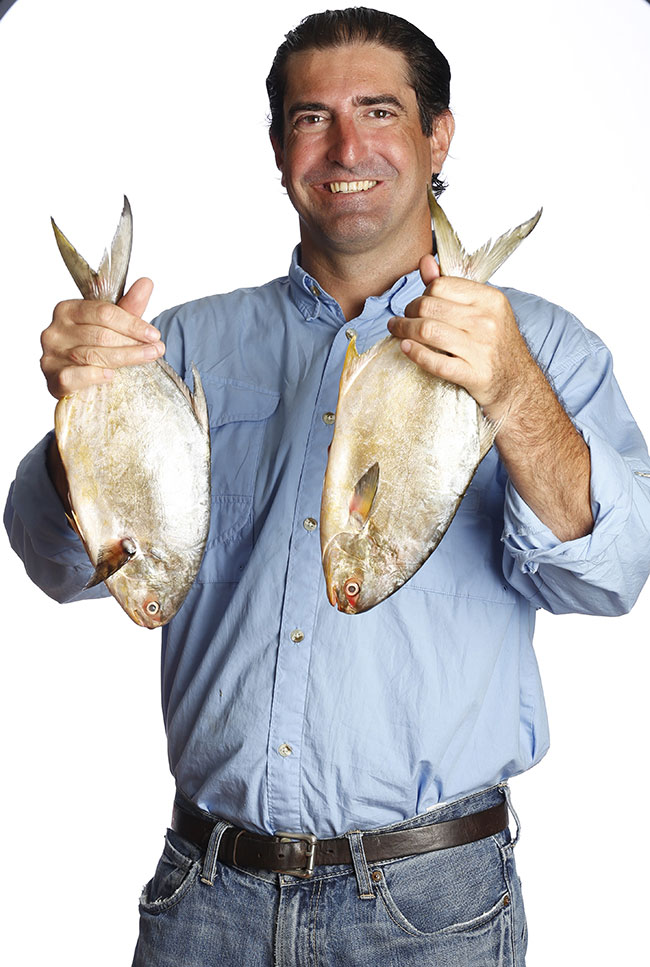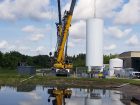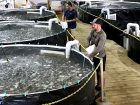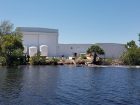
Features
Raising Florida pompano on land
Former banker brings business skills to build commercial RAS farm in Florida
January 7, 2020 By Liza Mayer
 Joe Cardenas, founder of Aquaco Farms, says growing Florida pompano from egg to harvest only takes nine months. It’s one of the reasons why he chose the species for his RAS farm.
Joe Cardenas, founder of Aquaco Farms, says growing Florida pompano from egg to harvest only takes nine months. It’s one of the reasons why he chose the species for his RAS farm. Joe Cardenas recognizes an opportunity when he sees one: demand for seafood is rising and Americans are growing increasingly aware of the origin of the food on their plates.
But while conducting due diligence gave him confidence in aquaculture’s potential, it took some six months before he decided to leave his job as a commercial banker and establish Aquaco Farms, a recirculating aquaculture system (RAS) facility raising Florida pompano (Trachinotus carolinus) in St Lucie, Florida.
“Bankers typically have been the least risk-takers I’ve ever met in my life,” Cardenas says. “They’re very, very conservative financially. And aquaculture is nothing but risk at this stage so it took me quite a long time before I could talk to my wife about quitting my job and taking this on, and luckily she supported it. My passion for fishing and the outdoors, combined with my experience in commercial banking led me to this great opportunity.”
No shortcuts
It’s been over four years since that conversation. Cardenas has since raised $3.2 million for the first phase of the privately-funded company, which he acknowledged didn’t get handed to him on a silver platter.
The challenge was finding the right partners and investors who understood the time it took to get a sound aquaculture project off the ground. His vision for a gradual scale-up was slower than what most potential investors would have liked. Some were looking at it purely from an investment play versus an impact-and-sustainability play that has a long-term return on investment.
“They didn’t quite grasp (our vision). They’d ask, ‘Why are you doing a Phase 1 and Phase 2, why not go out and raise $10 million to do it all at once? That’s how they do it in other industries.’ I had a lot of those conversations around and the best way to answer them was that we were operationally focused versus investor focused,” he says.
When the time came to build, the mantra, “Slow but steady wins the race,” also guided Cardenas. Aquaco’s gradual build-up shows a dramatically different picture from the mega RAS facilities being built in other parts of the US. Cardenas won’t have it any other way.
And he would be first to admit that passion alone doesn’t cut it. He made sure he surrounded himself with experts who have worked with fish in commercial settings and “checked their egos at the door.” That team of seven full-time employees, including Cardenas, did almost the entire build-out inhouse, from creating the design to building the infrastructure and constructing the wells, with the help of two consultants – an engineer and a biologist.
“Nobody led the discussion. It was all groupthink about the best pump company, the best drum filters, the best tank designer to use. It was just a conglomerate of different ideas in agreement,” Cardenas says.
The Aquaco team did everything their way despite the availability of studies on raising pompano in RAS systems. The, “Commercialization of Florida Pompano Production in Inland Recirculating Systems,” conducted in 2013 by the Harbor Branch Oceanographic Institute at Florida Atlantic University is one of those studies.
“We did not incorporate anything (from the study) because nothing they worked on really focused on a commercial scale. It doesn’t mean there’s no long-term benefit to their work but as far as having soundness of commercial design, or diets, for instance, there just wasn’t anything practical for us to wrap our arms around.”
He is more excited about the institute’s work with selective breeding that’s scheduled to begin in 2020. “That’s really where we will benefit. There really isn’t a lot we’re going to get from the larval rearing stage or any other points of efficiency other than from a selective breeding program. That’s one area where no one has started work yet on pompano.”
Wanting to do it right delayed the facility’s start but Cardenas was steadfast with his vision. “It was a long patient two years from the time we closed on our site to seeing our first fish swimming around. But I don’t regret it because of the outcome and the quality of it. Other projects have rushed themselves to failure.”
“We developed this farm the right way,” he continues. “There will be no ground injection for waste treatment. We will recirculate 97 percent of the water, keeping our fish healthy by continuously filtering out wastes to ensure clean, clear water.” The collected wastes will be sold for fertilizer.
Why pompano?
The 20,000-square-foot facility took in its first cohort of 30,000 Florida pompano fingerlings in July. By October, the fish were being readied for transfer from the nursery to the grow-out tanks. “They have shown great growth since our stocking in July and will be ready for harvest in February,” Cardenas happily shares.
Aquaco Farms sourced its first batch of fingerlings from a local vendor. But that could change soon. The company is planning to build its own hatchery to reduce its reliance on outside suppliers. It hopes to eventually source 80 percent of the fingerlings inhouse and the rest from the local vendor.
“The first step is to collect our broodstock from the wild this fall and start building our broodstock program,” Cardenas told RASTech in late summer. “We should have that completed by December and the next step after that is our hatchery.”
Aquaco Farms will eventually be able to sustainably produce one million pounds of fish a year from just 100 fish caught in the wild. The process from egg to harvest weight of between 1.25 to 1.5 lbs. takes nine months. That is a short grow-out period compared to other species, and one of the reasons Cardenas chose to raise Florida pompano. The other selling points are the fact that the species is native to Florida waters and they do well in dense quarters.
“They tend to school in the wild naturally so they school well in a tank. There’s also a lot of flexibility with their tolerances; they have a huge salinity range. I’d say their ideal zones of salinity is a trade secret but they can go all the way down to 10 ppt or survive in as high as 35 to 36. So they are a little less fragile than other species,” says Cardenas.
High demand and limited supply from fisheries was also a factor in the choice of Florida pompano. Although Florida dubs itself the “Fishing Capital of the World,” pompano wild catch is seasonal and very inconsistent. “I’ve met with a lot of commercial fishermen who have never concentrated on it as a career; it’s more of an opportunistic catch,” he says.
Aquaco is currently the only pompano farmer in North America and the only farmer raising the species in RAS on a commercial scale. The closest other producer is Dyer Aqua, a 250-metric-ton-a-year net-pen operation in Panama – it was the first company to supply the US market with fresh farm-raised pompano on a commercial scale, its website says.
RAS advantage
For Cardenas, the biggest advantage in growing the fish in RAS is logistics. Aquaco’s presence in the east coast of the US puts at its doorstep a potential market of 21.3 million people in Florida alone.
“Chefs have worked with wild pompano; it’s not a new species, but the biggest limiting factor is consistent availability, so that’s what we provide,” he says.
The company’s primary focus is to wholesale fresh, never-frozen pompano for delivery to the customer within 24 to 36 hours of harvest. “Wholesalers will come and pick up their orders. We will avoid processing and distribution for now, and that would be quite a bit of savings in packaging and shipping and going through customs. We have about $1.00 to $1.20-per-pound advantage in having a domestic product here and not having to ship it.”
Reducing environmental risk is another RAS advantage. “We’re indoors, we control all the water quality standards. A lot is in your control as far as temperature, salinity, pH, biosecurity. All that to me was all worth the additional money it took to build the type of system that we have. We know that nothing is 100-percent guaranteed, but we greatly increased the survivability of the fish by doing it the way we did.”
Expansion plans
Cardenas acknowledges that the initial production of 10,000 lbs. each month in the current first phase will barely scratch the surface. He estimates this volume is only enough to serve 35 restaurants. So he is planning an expansion, one that will see 100,000 lbs. of monthly production beginning in 2021, serving up to 350 restaurants.
That expansion includes the broodstock program, hatchery and the addition of 250,000 square feet to the existing site. Cardenas estimates Phase 2 will need around $7 million to $7.5 million, roughly twice the amount raised to fund Phase 1. The goal is to begin expansion work by February or March 2020.
“This is the time I turn my hat around from an aquaculturist and become a fundraiser again,” he says.
Fundraising for the scale-up is the biggest challenge for Cardenas. “Investors like to be told they’re going to make their return sooner, but I think people appreciated more that we were truthful from day one versus having to excuse the balance sheet down the road. I presented it very openly and honestly that this was not a two-year-return-on-capital type of project. It’s going to take us, at minimum, three to four years to start that profitability turnaround and start being able to distribute profits.”
That he has something concrete to show this time around could help attract potential investors. “It could be easier now that we have a working blueprint than when I was out there selling my idea to people. This makes it a little bit easier for audiences to understand what we do. Everyone’s been really happy with the results of Phase 1,” he says.
His life may have changed– working 30 hours more than he did as a banker – but he is happy with no regrets. “I’m here at the site probably 80 hours a week to not only do the administrative side, but to learn the aquaculture side. My guys trust me now to actually be around fish. That’s a good sign,” he laughs.
He added: “I’m 42 now and if someone asked me a little while ago if I would have done it 10 years sooner, my honest answer will be no, because I learned so much over the last 10 years.”
Valuable lessons include those he learned during his 15 years as head of commercial traditional lending, where he met business owners, examined their financials and got a glimpse of various leadership styles and what it took to succeed in various industries.
“There’s no crystal ball to show if we’re going to fail or succeed but I’m really happy with the lessons I have taken from my prior life if only to make sure that our budget was sound,” he says.
Aquaco has stayed within five to 10 percent of budget, he says. “We had budgeted $3 million and we came in at $3.2 million so that’s pretty good because my background was balancing project budgets in the past.”
Phase 2 is expected to be completed over the next 18 months. Aquaco plans to look for additional sites after that.
“I’m a big believer in having multiple locations than having one mega farm that’s cheaper in some sense but also more risky,” he says. “So I’d much rather maintain our headquarters here and expand by having an additional grow-out location in the state.”
He plans to stick with Florida pompano, as he expects current demand will continue to outweigh the supply. “We will stick with the species until the market tells us otherwise, such as when more competition comes down the line, which I’m sure will happen. But right now it’s all pompano. The margins are right. The fish is behaving as we wanted or better, and the pent-up demand has been great.”
Print this page


